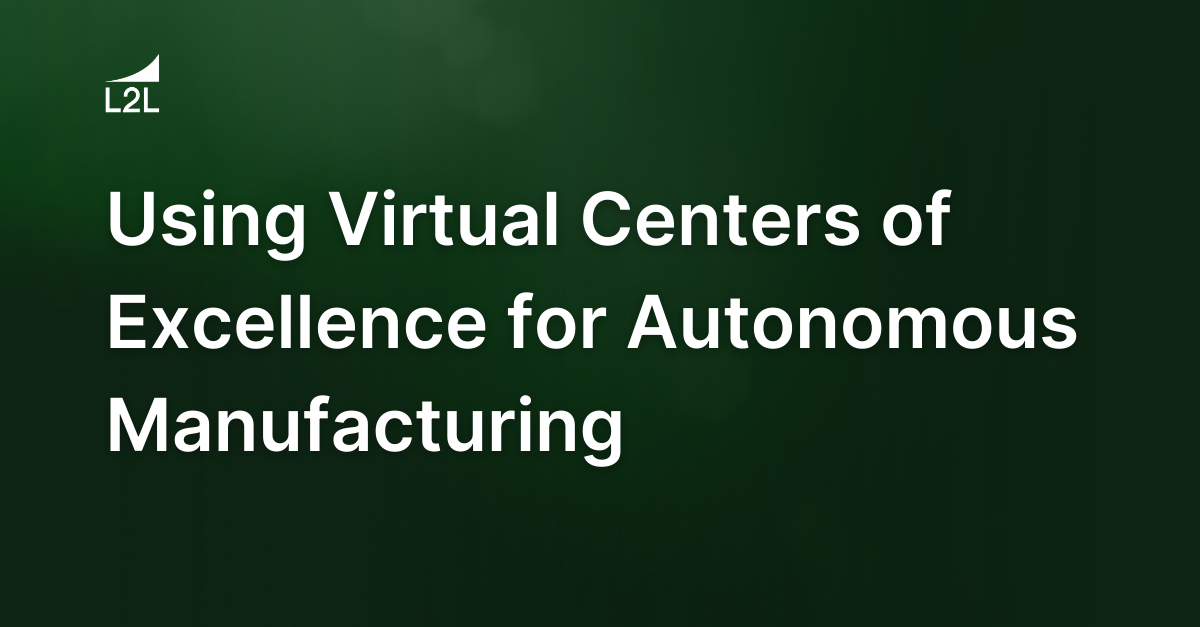
Today, the integration of digital transformation and AI is crucial in manufacturing. Yet, a significant barrier to innovation remains — the ongoing labor shortage. This shortage is a serious challenge that could stagnate the sector’s progress toward more automated and efficient operations.
At L2L, we believe that the solution lies not just in mitigating the labor shortage but in creatively leveraging the available labor to its fullest potential. In this post, we’ll explore how manufacturers can optimize labor through the creation of Virtual Centers of Excellence (VCE), accelerating their path to Autonomous Manufacturing.
Virtual Centers of Excellence in manufacturing: Definition and purpose
In the face of current labor shortages, the traditional model of a physical Center of Excellence (COE) is no longer feasible for many manufacturers, especially those with multiple sites. Instead, a Virtual Center of Excellence (VCE) offers a dynamic alternative.
Simply put, a VCE is a centralized place where people can collaborate across different geographical locations. These virtualized teams, comprised of manufacturing experts from various locations, collaborate remotely to drive corporate standards, disseminate best practices, and provide essential operations support across all plants within an enterprise.
Members of a VCE should comprise experts from every shop floor department. Successful cross-functional teams will have broad experience in Operations, IT, Engineering, OT Technology, Maintenance, Production, and Quality.
Best practices for creating a Virtual Center of Excellence in manufacturing
Finding available resources can be difficult for a manufacturing VCE. You’ll likely need to restructure daily work to free up your workforce for this additional role.
To create a VCE, you need to standardize your processes. Standardizing operations helps manufacturers significantly increase efficiency and “buy back” time and resources previously tied up in inefficient practices. With more time, you can deploy labor in ways that can catalyze further improvements and innovations across manufacturing operations.
Yokoten: Expanding improvements across the enterprise
Once manufacturers have streamlined their operations and freed up essential resources, the next step is to amplify these benefits across multiple facilities. Yokoten, the Japanese term for best practice sharing, becomes a critical strategy in this phase. By employing Yokoten, manufacturers can extend the reach of their efficiency gains from a single plant to the entire network of operations, ensuring that improvements and innovations are not siloed but are leveraged enterprise-wide. This is the core benefit found in starting a VCE.
Digital tools and AI: Enablers of the VCE model
The rise of digital tools and AI has transformed the potential of VCEs, enabling remote teams to operate more effectively than ever before. Through real-time dashboards, digital twins, and AI/machine learning analysis, these virtual teams can monitor operations, predict maintenance needs, and optimize production from anywhere in the world. This approach not only maximizes the use of available skilled labor but also accelerates the implementation of best practices and innovations across plants.
Accelerate your journey toward Autonomous Manufacturing with L2L
L2L’s platform is perfectly positioned to support the VCE model. Our Connected Frontline Worker (CFW) solution offers the tools necessary for effective communication, process standardization, and real-time operational oversight. By facilitating a seamless flow of information and best practices across industrial facilities, L2L helps manufacturers overcome geographical and operational barriers and create a cohesive and collaborative working environment.
As improvements and efficiencies are replicated across locations, manufacturers will experience a snowball effect — each success builds on the previous one, accelerating the pace of change and innovation. This momentum is crucial for the shift towards Autonomous Manufacturing, where the integration of AI and automation technologies can thrive on a foundation of streamlined and standardized processes.
The path to Autonomous Manufacturing requires more than just adopting new technologies. It demands a strategic rethinking of how labor is utilized and how improvements are implemented across the manufacturing landscape.
Reach out to sales@l2l.com or book a demo with us to discover how our products and the Virtual Center of Excellence model can help you leverage remote labor, share best practices, and innovate faster.
Revisions
Original version: 28 June 2024
Written by: Tyler Whitaker
Reviewed by: Daan Assen
Please read our editorial process for more information
Related Posts
Subscribe to Our Blog
We won't spam you, we promise. Only informative stuff about manufacturing, that's all.



